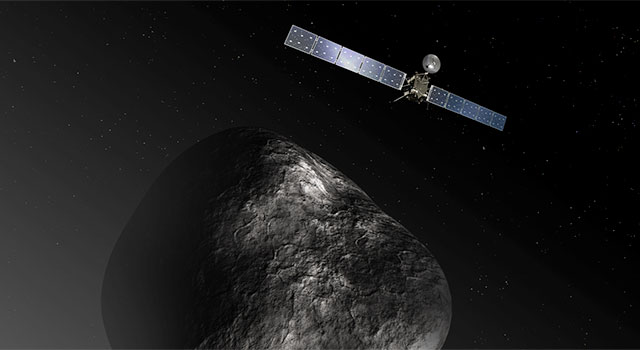Jul 1 2014
Comet 67P/Churyumov-Gerasimenko is releasing the Earthly equivalent of two glasses of water into space every second. The observations were made by the Microwave Instrument for Rosetta Orbiter (MIRO), aboard the European Space Agency's Rosetta spacecraft on June 6, 2014.
The detection of water vapor has implications not only for cometary science, but also for mission planning, as the Rosetta team prepares the spacecraft to become the first ever to orbit a comet (planned for August), and the first to deploy a lander to its surface (planned for November 11).
 This artist's impression shows the Rosetta orbiter at comet 67P/Churyumov-Gerasimenko. The image is not to scale. Image Credit: ESA/ATG Medialab
This artist's impression shows the Rosetta orbiter at comet 67P/Churyumov-Gerasimenko. The image is not to scale. Image Credit: ESA/ATG Medialab
"We always knew we would see water vapor outgassing from the comet, but we were surprised at how early we detected it," said Sam Gulkis, principal investigator of the MIRO instrument at NASA's Jet Propulsion Laboratory in Pasadena, California. "At this production rate, comet 67P/Churyumov-Gerasimenko would fill an Olympic-size swimming pool in about 100 days. But, as the comet gets closer to the sun, the gas production rate will increase. With Rosetta, we have an amazing vantage point to observe these changes up close and learn more about exactly why they happen."
MIRO first detected water vapor from the comet when the Rosetta spacecraft was about 217,000 miles (350,000 kilometers) away from it. At the time, comet 67P/Churyumov-Gerasimenko was 363 million miles (583 million kilometers) from the sun. After the initial June 6 discovery, water vapor was also detected every time the MIRO instrument was pointed toward the comet. Observations are continuing to monitor variability in the production rate, and to determine the global gas production rate, as a function of its distance from the sun. The gas production rate that MIRO determined provides scientists a measure of the evolution of the comet as it moves both toward, and then away, from the sun. The gas production rate is also important to the Rosetta navigation team controlling the spacecraft, as this flowing gas can alter the trajectory of spacecraft.
"Our comet is coming out of its deep-space slumber and beginning to put on a show for Rosetta's science instruments," said Matt Taylor, Rosetta's project scientist from the European Space Agency's Science and Technology Centre in Noordwijk, The Netherlands. "The mission's engineers will be using this MIRO data to help them plan for future mission events when we are operating in close proximity to the comet's nucleus."
Rosetta is currently about halfway between Mars and Jupiter, 261 million miles (420 million kilometers) from Earth and 354 million miles (569 million kilometers) from the sun. Comets are time capsules containing primitive material left over from the epoch when the sun and its planets formed. By studying the gas, dust and structure of the nucleus and organic materials associated with the comet, via both remote and in-situ observations, the Rosetta mission should be a key to unlocking the history and evolution of our solar system, as well as answering questions regarding the origin of Earth's water and perhaps even life. Rosetta will be the first mission in history to rendezvous with a comet, escort it as it orbits the sun, and deploy a lander to its surface.
MIRO is a small and lightweight spectrometer instrument, the first of its kind launched into deep space. The MIRO science team is composed of 22 scientists from the United States, France, Germany and Taiwan. Resembling a miniaturized ground-based radio telescope, it was designed to study the composition, velocity and temperature of gases on or near the comet's surface and measure the temperature of the nucleus down to a depth of several inches, or centimeters. Studying the nucleus temperature and evolution of the coma and tail provides information on how the comet evolves as it approaches and leaves the vicinity of the sun, and addresses questions about why that happens. During Rosetta flybys of the asteroids (2867) Steins and (21) Lutetia in 2008 and 2010 respectively, the instrument measured thermal emission from these asteroids and searched for water vapor.
MIRO is one of three U.S. instruments aboard the Rosetta spacecraft. The other two are an ultraviolet spectrometer called Alice, and the Ion and Electron Sensor (IES). They are part of a suite of 11 science instruments aboard the Rosetta orbiter. NASA also provided part of the electronics package for the Double Focusing Mass Spectrometer, which is part of the Swiss-built Rosetta Orbiter Spectrometer for Ion and Neutral Analysis (ROSINA) instrument. NASA's Deep Space Network is supporting ESA's Ground Station Network for spacecraft tracking and navigation.
The Microwave Instrument for Rosetta Orbiter (MIRO) was built at JPL. Hardware subsystems for MIRO were provided by the Max-Planck Institute for Solar System Research and the Laboratoire d'Etudes du Rayonnement et de la Matiere en Astrophysique of the Observatoire de Paris. The consortium also includes the Laboratoire d'Etudes Spatiales ed d'Instrumentation en Astrophysique of the Observatoire de Paris.
Rosetta is an ESA mission with contributions from its member states and NASA. Rosetta's Philae lander is provided by a consortium led by the German Aerospace Center, Cologne; Max Planck Institute for Solar System Research, Go?ttingen; French National Space Agency, Paris; and the Italian Space Agency, Rome. JPL, a Division of the California Institute of Technology, Pasadena, manages the U.S. contribution of the Rosetta mission for NASA's Science Mission Directorate in Washington. JPL also built the MIRO and hosts its principal investigator, Samuel Gulkis. The Southwest Research Institute (San Antonio and Boulder), developed the Rosetta orbiter's IES and Alice instruments, and hosts their principal investigators, James Burch (IES) and Alan Stern (Alice).
More information about Rosetta is available at: http://www.esa.int/rosetta
For more information on the DSN, visit: http://deepspace.jpl.nasa.gov/dsn